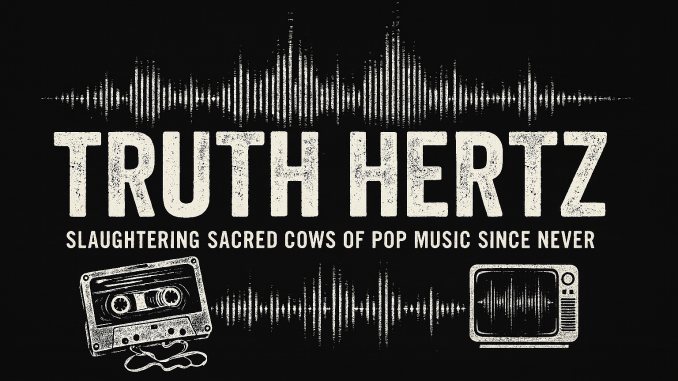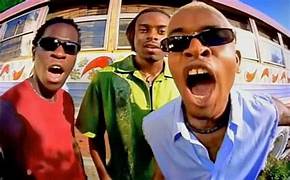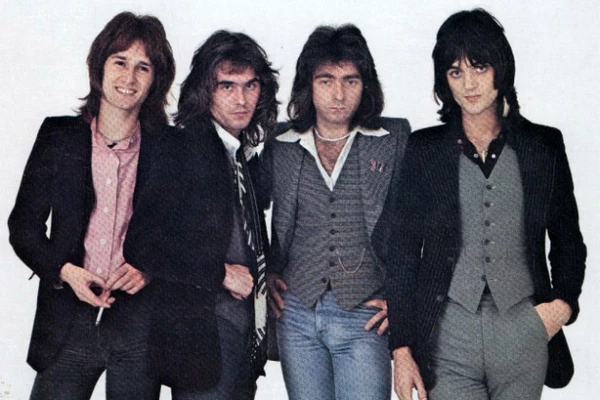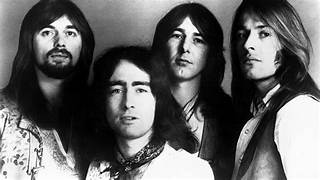
Welcome to The Truth Hertz — where we apply a cold compress to your overheated nostalgia.
#1) Baha Men

RATING: ⭐
GENRE: Dance, Pop, Reggae
YEARS ACTIVE: 1985-2015 (11 Studio Albums)
If aliens landed in the year 2000 and asked, “What is Earth music?” and someone handed them “Who Let the Dogs Out,” they’d leave immediately and file a noise complaint with the galaxy. But let’s be fair—they didn’t create this beast alone. “Who Let the Dogs Out” was a Frankenstein of committee-written chaos, originally penned by a Trinidadian artist and passed around like a musical hot potato until it landed in the Baha Men’s lap like a curse wrapped in a Grammy.
Their follow-ups? “Move It Like This” and “Best Years of Our Lives”—songs best known for appearing in Shrek soundtracks, Carnival cruise commercials, and the background of every straight-to-DVD sequel ever made
Baha Men were not a band. They were a sonic event—like a tropical storm made of subwoofers and rubber dog toys.
#2) Backstreet Boys

RATING: ⭐
GENRE: Pop, Dance-Pop
YEARS ACTIVE: 1996-2022 (10 Studio Albums)
They weren’t a band so much as a vocal committee—assembled in a Florida sound lab by Lou Pearlman (aka the Willy Wonka of musical tax fraud). They were like five shades of beige performing emotional PowerPoint presentations set to Auto-Tune.
The Backstreet Boys weren’t artists—they were human Capri Suns: sweet, disposable, and mysteriously sticky. They didn’t write songs, they uploaded processed feelings into a teenage hive mind via JNCO jeans and hair gel. And yes, they sold 100 million records. But so did plastic straws before we realized how much damage they caused.
#3) Babyface

RATING: ⭐
GENRE: R&B, Soul, New Jack Swing
YEARS ACTIVE: 1986-2022 (9 Studio Albums / 6 Collaboration Albums)
This is a guy who made an entire career out of sounding like the emotional equivalent of beige carpeting. Aaliyah may have whispered in your ear with mystery and subtle rebellion. Babyface? He crooned like he was auditioning to narrate a prescription drug commercial. “Ask your doctor if slow jams are right for you…”
Let’s be clear: the man wrote everything. If there was a teardrop, a wind machine, or a satin bedspread in an R&B video from 1987 to 1999, Babyface wrote that track in a silk robe between sips of Evian. As a solo artist, he’s like the R&B version of a dinner mint—refreshing, gentle, technically flawless, but completely forgettable after five minutes. He’s the undisputed king of “safe sex jams.” The only man who could make a breakup feel like a mutually agreed-upon HR exit interview. And apparently, a lot of listeners love him for it. But like Aaliyah, he bores me to tears.
#4) The Babys

RATING: ⭐
GENRE: Pop rock, Hard rock, Power pop
YEARS ACTIVE: 1976-1980 (5 Studio Albums)
Let’s talk production. Their songs are so glossed, buffed, and airbrushed, you’d think they were recorded inside a bottle of Vidal Sassoon mousse. Strings! Synths! Horns! Backup singers who sound like they were kidnapped from a Hallmark movie! And for what? Every track sounds like the climax of a made-for-TV breakup scene.
The Babys were the sonic equivalent of white wine spritzers and emotional repression. And somehow… somehow… they still got played between Zeppelin and Sabbath on classic rock radio. Which is the real crime.
#5) Baby Huey

RATING: ⭐⭐
GENRE: Psychedelic Soul, R&B
YEARS ACTIVE: 1971 (1 Studio Album)
Let’s be honest: Baby Huey is one of those artists whose myth looms larger than the actual tracklist. Yes, he had the voice—a sledgehammer wrapped in velvet, capable of both pain and power. But when people praise The Baby Huey Story: The Living Legend, what they’re usually doing is projecting what could have been, not necessarily what was.
Because that lone, posthumous album? It’s wildly uneven. Half of it feels like a psychedelic soul experiment, the other half sounds like the house band at a Motown-themed roller disco had too much cough syrup. You can almost hear the producer whispering, “Just let him go off… maybe it’ll turn into magic.”
And in moments, it does. But in others? It’s raw, rambling, and drenched in what-ifs. He showed us the potential for a new kind of soul: psychedelic, political, primal. But to pretend that one half-baked, posthumous album equals genius? That’s not tribute—that’s wishful thinking.
He’s not overrated.
He’s just underrecorded.
#6) Badfinger

RATING: ⭐⭐
GENRE: Rock, Power-Pop
YEARS ACTIVE: 1970-1981 (8 Studio Albums)
Badfinger were this close to greatness.
Signed to Apple Records. Mentored by Paul McCartney. Slide guitar courtesy of George Harrison.
And yet… somehow they managed to become the world’s most tragic cautionary tale in bell-bottoms. They were constantly one step away from the spotlight, like a band that kept showing up to the wrong door on The Ed Sullivan Show.
Badfinger had the talent. They had the songs. They even had The Beatles literally handing them hits. But somehow, they managed to turn a golden opportunity into a case study in cosmic irony. They’re the band equivalent of inheriting a Ferrari… and then driving it into a pond because the map was upside down.
#7) Badly Drawn Boy

RATING: ⭐⭐
GENRE: Indie Rock, Indie folk
YEARS ACTIVE: 2000-2020 (9 Studio Albums)
Let’s get one thing straight: Damon Gough (aka Badly Drawn Boy) is undeniably talented.
He can craft a gorgeous melody out of two chords and a sigh, and his debut, The Hour of Bewilderbeast, was a genuine lightning-in-a-beanie moment. But let’s also admit: the man sometimes confuses “eccentric” with “unfocused,” and “charm” with “chaos.”
His albums often feel less like cohesive statements and more like emotionally fragile mixtapes handed to you by a sleep-deprived philosophy major at 3am. Badly Drawn Boy is the musical equivalent of your endearingly scattered friend who’s always late, always brilliant, and always humming something under his breath.
You admire the heart.
You tolerate the tangents.
But you secretly wish he’d trim 6 tracks per album.
#8) Bad Religion

RATING: ⭐⭐
GENRE: Punk rock, Skate punk, Melodic hardcore
YEARS ACTIVE: 1982-2019 (17 Studio Albums)
Let’s start with respect: Bad Religion are legends. They’ve been around since 1980, survived lineup changes, Reagan, grunge, and the iPod—without ever abandoning their sound or their message. That’s rare. That’s admirable. That’s… kind of the problem.
There’s something admirable about Bad Religion’s refusal to “sell out,” but let’s be real: they haven’t evolved so much as they’ve refined one template for over 40 years. There’s no weird ska phase, no synth-drenched misfire, no acoustic introspection album. And while fans love them for that… it also means they rarely surprise you.
Bad Religion are pillars of punk—smart, reliable, principled. But their brilliance is often boxed in by repetition and a lack of sonic risk-taking. They may preach against conformity, but musically? They’ve spent four decades in a very well-decorated, self-built box.
#9) B-52’s

RATING: ⭐⭐
GENRE: New wave, Dance rock, Post punk
YEARS ACTIVE: 1979-2008 (7 Studio Albums)
There’s no denying that The B-52s were original. They sounded like no one else. They looked like no one else. They refused to take rock and roll seriously, and that refusal was their secret weapon.
But it was also their biggest limitation.
There’s a ceiling to how far you can go when your aesthetic is purposeful absurdity. For all their energy, their catalog doesn’t evolve much. Even their biggest hit, “Love Shack,” is just a shinier, radio-polished version of the same formula that made “Rock Lobster” work a decade earlier.
The B-52s were a vital spark in late-70s and 80s alt-pop—a joyful, defiant rejection of rock seriousness. But their devotion to camp, chaos, and kookiness also limited their artistic range.
They were brilliant at being them—but sometimes that brilliance came with a very specific shelf life.
#10) Bad Company

RATING: ⭐⭐
GENRE: Hard rock, Blues rock
YEARS ACTIVE: 1974-1996 (12 Studio Albums)
Bad Company had the credentials. They were a supergroup—Paul Rodgers from Free, Mick Ralphs from Mott the Hoople, Simon Kirke on drums, and even King Crimson’s Boz Burrell on bass.
And for a while there, it worked. Their sound was lean, confident, and built for arenas.
But here’s the truth: Bad Company didn’t reinvent the wheel. They polished it, slowed it down, and made sure it looked good on the back of a denim jacket. And let’s talk consistency.
After their first few albums, the spark faded quickly. By the early ’80s, they’d become the kind of band that classic rock radio kept alive out of obligation, not demand. Rodgers’ voice never lost its power, but the songwriting grew increasingly generic. When he left, so did the soul.
Bad Company were solid craftsmen with a handful of undeniable anthems. They had a great singer, a tight sound, and enough swagger to sell it. But beneath the surface, they were often formulaic, lyrically shallow, and sonically cautious—a band more respected than revered, more consistent than inspired. They didn’t so much break new ground as stand firmly on it… with a beer in hand, guitar in lap, and another verse about a woman walking out the door.
FINAL SCORECARD: THE B-SQUAD REVIEWED
| Artist | ★ Rating | Summary |
|---|---|---|
| Baha Men | ★☆☆☆☆ | One dog, many barks, zero replay value. A novelty track that overstayed its welcome and stole a Grammy while no one was looking. |
| Backstreet Boys | ★☆☆☆☆ | Five synchronized haircuts and a dream. Emotional safety scissors disguised as pop. They’re back, alright—but why? |
| Babyface | ★☆☆☆☆ | Smooth to the point of sedation. R&B’s leading cause of adult contemporary-induced naps. |
| The Babys | ★☆☆☆☆ | Power ballads for people who find Foreigner too edgy. Overproduced, underwhelming, and thoroughly “meh.” |
| Baby Huey | ★★☆☆☆ | A soul-shouting legend in theory, a chaotic posthumous mixtape in practice. One amazing song, a lot of potential echoes. |
| Badfinger | ★★☆☆☆ | Beatles Jr. with tragic flair. Beautiful melodies buried under bad management and even worse luck. |
| Badly Drawn Boy | ★★☆☆☆ | Wool-hatted brilliance often lost in its own clutter. Gorgeous fragments, but bring a broom. |
| Bad Religion | ★★☆☆☆ | Punk’s valedictorian. Sharp, principled, and just a touch too comfortable repeating the same test answers since 1988. |
| The B-52s | ★★☆☆☆ | Fabulously weird and fun—for about 3 songs. Then it’s just shouting about seafood and dancing in wigs. |
| Bad Company | ★★☆☆☆ | Bar-band royalty who made arena rock feel like a grizzled shrug. Great voice, average ambition. |
RECOMMENDED:
BAD RELIGION – (CompIlation)
B-52s – (CompilatIon)
BAD COMPANY – (Bad Company 1974)

Leave a Reply